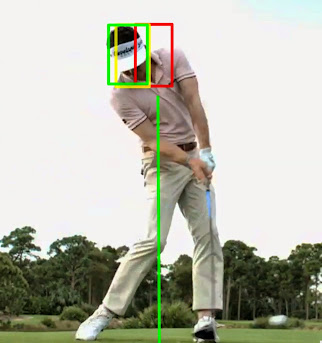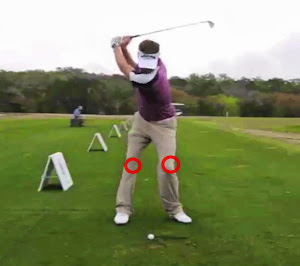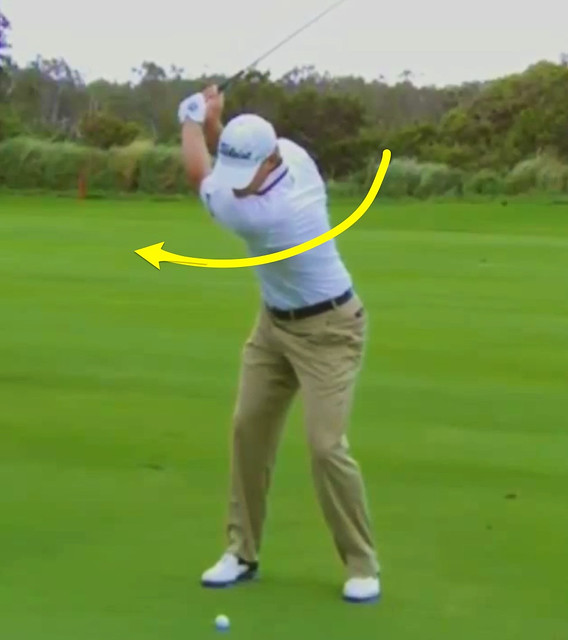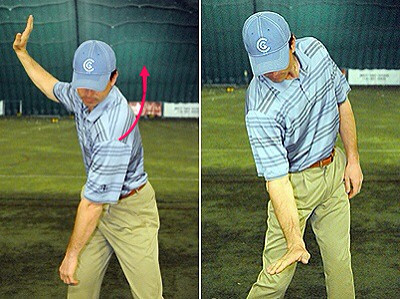 |
| Bradley's Head Movement |
In addition, I monitor the following points: The 20-20 head swivel applies to the neck and head ONLY; be careful that you're not turning and tilting your torso more than the standard setup position, which can cause fat shots and shanks (remember, it's a "1-2" head movement only after standard address). The club head is lightly touching the ground behind the ball--almost hovering. I also let the club head lag my hands on the takeaway, keeping the club head outside my hands and ensuring my wrists are relaxed, so that I can sense a loaded club at the top and better retain lag coming down. Keep the club face pointing at the ball during the takeaway. Grip: Use a somewhat strong left hand grip and a neutral to weak right hand grip for most shots (alterations can be used to shape shots). I now understand Clement's analogy of "hammering into a door frame" and why one's head must be behind the ball (Would you hammer into a door frame with your head in front of it? Of course not; you wouldn't be able to see it or get any leverage). Though the 20-20 head swivel hinders the tendency of the upper-body to sway to the right on the backswing, the hips can still sway to the right, so be aware of this--all that's necessary is a rotation of the torso; no additional rightward shifting is necessary. I believe there are only a few universal requirements for a good golf swing, such as a FLW and forward shaft lean, and I also believe that staying behind the ball through impact is one of them.
You'll also see that all modern pro golfers get behind the ball through impact; most simply don't preset it the way Nicklaus and Snead did at address or as a swing trigger--they achieve the correct head position while in motion, which contributes to the illusion that they stay on top of the ball because of their address positions. Examine the image of Keegan Bradley above. The vertical green line represents the back of the golf ball at address. The colored boxes mark his head positions throughout the swing: red is at address, yellow is at the top, and the green box is at impact. His head position at address is level and right on top of the ball, but by impact his head is well behind the ball's position and tilted right. The modern way to achieve Nicklaus' head position is to move into it during the swing; amateurs like me are better off presetting it address and leaving it there, as the former requires greater timing.
Another reason that this probably makes a difference for me is that I'm right-handed but left eye-dominant, which is not typical. Thus, I'm getting my left eye right on back of the ball.
You have to swing the club. To do that, your body must be in position, beginning with your head, which needs to start behind the ball and stay there all the way through impact.
Jack Nicklaus: My Lifetime Principles For Great Golf
First, it is a positive move, like the forward press of the hands, from which to start the backswing. Second, turning the head to the right makes it possible to take a longer, freer turn with the whole body than would be possible if the head were held straight to the front. Third, and most important, it is a method by which we help brace ourselves against swaying to the left on the downswing and moving our body out ahead of the ball at impact—a sure way to ruin a golf swing.
Give Every Shot A Cockeyed Look - 02.17.64 - Jack Nicklaus
[Sam] Snead suggests that if we tilt our head slightly in the direction of our backswing, it will relieve a lot of the tension in the back and left side that keep us from making a full turn.
Snead Says, "Tilt Your Head To Help Relieve Tension During Your Backswing"
Jack Nicklaus was famous for turning his chin to the right before he took the club back. He moved his chin (head) to the right so that he [could] turn freely during the backswing.
Also, tilt your head slightly to the right at address. Because your spine should be tilted to the right at address, your head should be tilted as well.
The Head Movement during the Golf Swing
Most people's dominant eye is on the same side as their dominant arm, leg, etc. However, despite being right handed, I am left eye dominant. So is Jack Nicklaus.
3Jack Golf Blog: The Dominant Eye and Golf
Joe Dante, one of America’s best known teaching professionals, from his book Four Magic Moves To Winning Golf. “Keep the head still.” This impossible advice has been given in one form or another for about as long as there has been any literature on golf: “Keep your head down.” Keep your head still.” Keep your head fixed.” “Keep your eye on the ball.” “Don’t lift your head.” “Don’t look up.” You’ve heard these directions a thousand times. If they would only say, “Keep your head back,” they would be much closer to being right.
Expert Advice - Head Movement
The best way to stay behind the ball is to start with your head positioned behind the ball in your set-up. As you swing, keep your head from moving in front of the ball. You’ll turn through the ball correctly, resisting any tendency to lunge forward in the downswing, which can cause poor contact and any number bad shots.
It’s vital, however, that we make sure our weight moves to our front foot to begin the downswing. In an effort to stay behind the ball, many inexperienced golfers hang back on their back foot during the downswing, the dreaded reverse pivot. The result is usually a weak push or slice.
Golf Tips; Stay Behind the Ball
Staying behind the ball doesn’t mean limiting your rotation or your weight shift toward your forward side. Rather, staying behind the ball means keeping your spine tilted away from the ball at impact and bracing against a strong left side.
Slice Killers! | GolfTipsMag.com
The most difficult thing for the average golfer to do, in my opinion, is to stay behind the ball. He has a tendency to move ahead of the ball with the body, and in doing so he develops an outside-in swing which causes such familiar troubles as slicing, shanking, and topping. This is particularly true on the drive, which so many players try to hit with too much power.
Staying Behind The Ball
The point is…you need to have tilt behind the ball at address and tilt behind the ball at impact with your weight moving toward your front side…and you need to find a feel that gets you there.
Tilt behind the ball at impact
If you start with your head directly over the top of your belt buckle then you must move your head over to your right shoe on the backswing. If you start with your head more toward your right shoe than your belt buckle, you won't need to move as much.
Golf Instruction: Keep Your Head Still
In Harvey Penick's, The Little Red Book, published in 1992, page 75 is entitled "Stay Behind the Ball" "All great golfers move their head slightly backward before and during impact, but never forward. A golfer must stay behind the ball. I mean set up with your head behind the ball and keep your head behind the ball. If you move your head forward during your downswing or through impact, you will hit a wee, ugly shot, probably a pulled slice."
Keep Your Head Back and Behind the Ball Through Impact! Six Top Golf Pros Agree
During the transition, his head naturally moves forward with the weight shift to the left side and his head gets further out in front of the ball by the time he arrives at impact. This forces him to release the club early just to make contact.
How to Keep Your Head Behind the Ball in the Golf Swing
Here's an easy way to help keep your head back and have an aggressive release. Simply focus your eyes on the back inside quadrant of the ball at address and remain focused on that spot on the ball until after impact. Doing that will guarantee that you keep your head behind the ball.
Big Play: Ted Potter Jr homemade swing
If you want to increase your clubhead speed while reducing tension, learn to lag―swinging the clubhead away from the ball last. Begin the backswing by rotating the upper body, while keeping the hands and arms passive. If the arms are truly relaxed, they’ll only move as a result of the torso turn. The clubhead holds its address position until everything else is in motion; once it moves, it “lags” behind the body.
Lag Behind to Get Ahead





